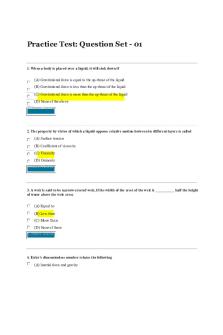Blood, Tissue Fluid and Lymph 2 PDF

| Title | Blood, Tissue Fluid and Lymph 2 |
|---|---|
| Course | Biology - A1 |
| Institution | Sixth Form (UK) |
| Pages | 2 |
| File Size | 44 KB |
| File Type | |
| Total Downloads | 8 |
| Total Views | 124 |
Summary
Notes on Blood, Tissue Fluid and Lymph Biology A Level OCR A...
Description
Blood, Tissue Fluid and Lymph Erythrocytes Structure Erythrocytes have a diameter of 7μm This is small – the average cell is 40μm in diameter Therefore, the hemoglobin is very close to the plasma membrane – as a result oxygen is loaded and unloaded very quickly in and out of the cell Capillaries are 8μm wide – only allowing 1 Erythrocyte through at a time
Plasma proteins and blood pressure About 8% of blood plasma consists of plasma proteins, of which about half may be albumins. These are a group of small proteins involved in the transport of other substances (e.g fatty acids, hormones) and which help regulate the osmotic pressure of blood. The balance between the hydrostatic pressure of blood (‘blood pressure’) and the osmotic pressure of blood is important in the formation of tissue fluid.
Blood Water Potential Substances dissolved in the blood plasma can move in and out of the capillaries Some large proteins, such as albumin, have an osmotic effect They cause the blood to have a relatively low water potential As a result, water tends move into the blood from surrounding tissues by osmosis This is called oncotic pressure = -3.3 kPa
Permeability of capillaries In the formation of tissue fluid blood plasma and the dissolved substances moves out into the body’s cells The table shows the relative permeability of the substances in blood...
Similar Free PDFs

Blood, Tissue Fluid and Lymph 2
- 2 Pages

blood and lymph lecture
- 11 Pages

Blood- Tissue- Flagellates
- 7 Pages

Tissue and Skin Lab
- 17 Pages

Fluid and Electrolyte ATI
- 5 Pages

Fluid and Electrolytes
- 23 Pages

Fluid Mechanics 2 MCQ
- 109 Pages

Bio 2 blood pdf
- 19 Pages

Fluid Mechanics and Hydraulics
- 5 Pages

FLUID MECHANICS AND HYDRAULICS
- 159 Pages
Popular Institutions
- Tinajero National High School - Annex
- Politeknik Caltex Riau
- Yokohama City University
- SGT University
- University of Al-Qadisiyah
- Divine Word College of Vigan
- Techniek College Rotterdam
- Universidade de Santiago
- Universiti Teknologi MARA Cawangan Johor Kampus Pasir Gudang
- Poltekkes Kemenkes Yogyakarta
- Baguio City National High School
- Colegio san marcos
- preparatoria uno
- Centro de Bachillerato Tecnológico Industrial y de Servicios No. 107
- Dalian Maritime University
- Quang Trung Secondary School
- Colegio Tecnológico en Informática
- Corporación Regional de Educación Superior
- Grupo CEDVA
- Dar Al Uloom University
- Centro de Estudios Preuniversitarios de la Universidad Nacional de Ingeniería
- 上智大学
- Aakash International School, Nuna Majara
- San Felipe Neri Catholic School
- Kang Chiao International School - New Taipei City
- Misamis Occidental National High School
- Institución Educativa Escuela Normal Juan Ladrilleros
- Kolehiyo ng Pantukan
- Batanes State College
- Instituto Continental
- Sekolah Menengah Kejuruan Kesehatan Kaltara (Tarakan)
- Colegio de La Inmaculada Concepcion - Cebu





